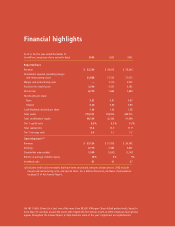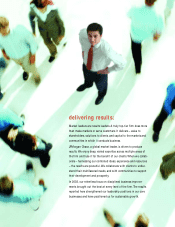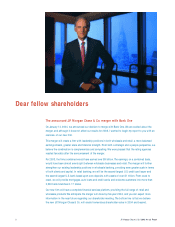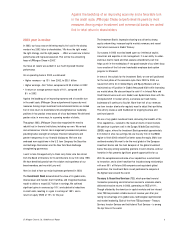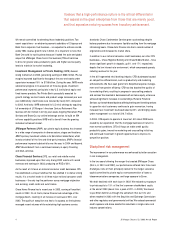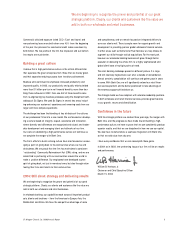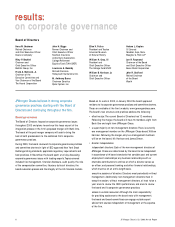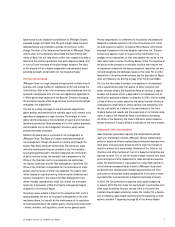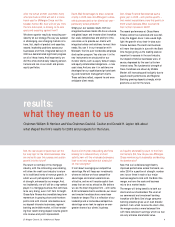JP Morgan Chase 2003 Annual Report Download - page 11
Download and view the complete annual report
Please find page 11 of the 2003 JP Morgan Chase annual report below. You can navigate through the pages in the report by either clicking on the pages listed below, or by using the keyword search tool below to find specific information within the annual report.
J.P. Morgan Chase & Co. / 2003 Annual Report 9
results:
what they mean to us
After the tumult of 2001 and 2002, many
who look back at 2003 will call it a transi-
tional year for JPMorgan Chase and the
broader market. Bill, how well do you think
the firm did overall, in sticking to its core
goals and executing against them?
We drove superior results by executing con-
sistently on our strategy. The way you succeed
in challenging, ever-changing markets is to
have, first, depth of product and expertise;
second, leadership positions across your
businesses; and third, integrated delivery. In
2003 we demonstrated significant progress
on all of these fronts. And importantly, we
did this while dramatically reducing concen-
trations and risk in our credit and private
equity portfolios.
David, Wall Street began to show renewed
vitality in 2003. How did JPMorgan’s whole-
sale businesses deliver for clients last year –
particularly across products?
Simply put, our success results from our
integrated business model. We have a diverse
and global issuer and investor client franchise.
Our scale, completeness and ability to inno-
vate allow us to provide our clients with
integrated advice and solutions to meet their
needs. You saw it in our transaction with
Microsoft, the first-ever transferable employee
stock option program. You also saw it in the
new instruments we structured for our
investor clients, such as equity default swaps
and equity collateralized obligations – a new
asset class. And you saw it in solutions we
developed for our sophisticated private bank-
ing and investment management clients.
These solutions reflect, respond to and even
anticipate client needs.
Don, the last couple of years have set the
bar very high for the retail businesses. How
can we build upon this success and sustain
growth into the future?
The return to normalcy in the mortgage
industry, with the refinancing wave abating,
will allow the credit card industry to return
to its traditional levels of revenue growth, in
which we will participate from a position
of strength, enhanced by our merger. And,
not incidentally, we will still be a top-ranked
player in a mortgage business that continues
to be very strong, even if off from its height.
Chase Auto Finance has incredible long-term
momentum in growing share and therefore
profits. And with interest rate declines over,
our deposit-intensive businesses, regional
banking and middle market, will be translat-
ing their recent strong deposit volume growth
into revenue and profit improvement.
As liquidity and stability return to the finan-
cial markets, Bill, how do you see JPMorgan
Chase maintaining its leadership and beating
the benchmarks?
Now that we’ve delivered significantly
improved performance across the board, we
enter 2004 in a position of strength: number
one, two or three in each of our major
business segments. And with the Bank One
merger, we have the scale and business
mix to be a market leader.
The merger will bring benefits to both our
clients and our shareholders. The union of
our commercial and investment banking
franchise with Bank One’s huge consumer
banking presence gives us an even broader
platform from which to serve the client. Also,
the merger creates a more balanced firm
with more consistent earnings, which we feel
can only enhance shareholder value.
David, with markets rebounding and firms
bracing for a renewed flurry of client
activity, how will the wholesale businesses
look to not only capitalize but also build
on their strengths?
It’s all about leveraging our competitive
advantage. We will focus our investments
where we believe we have competitive
advantages and market economics are
attractive, and we will recycle capital from
areas that are not as attractive. We believe
we are the most integrated firm – with some
8,000 wholesale clients worldwide, our issuer
and investor franchises have never been
broader or deeper. This is a reflection of our
leadership and a tremendous competitive
advantage as we look to capture an ever-
greater share of our clients’ business.
Chairman William B. Harrison and Vice Chairmen David A. Coulter and Donald H. Layton talk about
what shaped the firm’s results for 2003 and prospects for the future.
Don, Chase Financial Services had such a
great year in 2002 – with profits up 64% –
that market expectations were that profits in
2003 would decrease. What was behind
their further increase in 2003?
The record performance at Chase Home
Finance cannot be overstated and was defi-
nitely the biggest driver. I also would high-
light the growth of our best-in-class auto
finance business. The credit card business
will more than double in size with the Bank
One merger, giving us the leading scale so
important to success in the card industry.
Our deposit-intensive businesses were, of
course, depressed by the year’s ultra-low
interest rates. The fundamental strength of
these franchises was shown by Middle
Market still increasing profits slightly due to
superb credit performance, and Regional
Banking growing deposits strongly, which
positions us well for the future.


